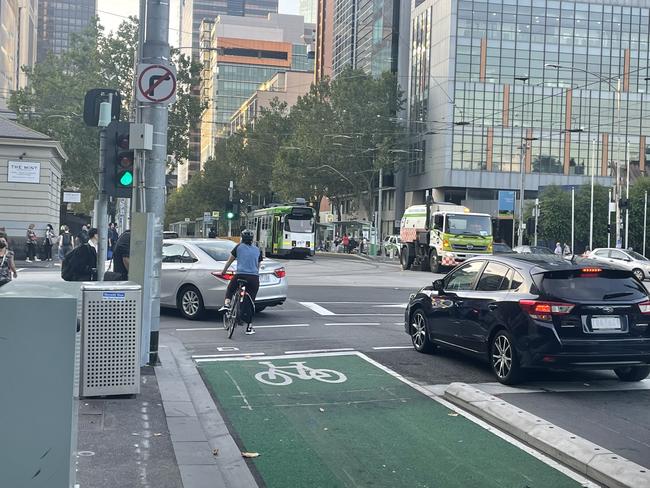Just one in four vehicles is a bicycle as new lanes clog up the city
Bike lanes installed by Melbourne City Council remain largely empty while cars and trucks juggle for space and some motorists say it’s deterring them from coming into the CBD.
Victoria
Don't miss out on the headlines from Victoria. Followed categories will be added to My News.
Cyclists account for just one in four vehicles on Melbourne’s CBD streets where controversial separated bike lanes have been installed by the city council.
A traffic count, conducted at morning and evening peaks by the Herald Sun this week, found that cars and trucks were jammed for space because of the loss of lanes.
On Queens Bridge the problem was worse with the number of cars and trucks five times that of bicycles, creating a bottleneck headache. Motorists were squeezed into just one lane as the second lane turned into a wide space for bikes.

Several cyclists even ignored the often-empty lane altogether to ride on the footpath among pedestrians heading to and from work.
The city council has rolled out 16km of a planned 40km of protected bike lanes, sparking an outcry from motorists, traders and delivery drivers over the loss of access, parking spots and road space.
The Herald Sun count was conducted in 20-minute periods on traditionally busy cycling routes on a fine day, conducive to riding.
Opponents of the bike lane program say it’s deterring motorists from coming into the city which is struggling to fight back after pandemic restrictions. They say delivery and taxi drivers are also inconvenienced and that people who drive into the city may need their vehicle for work or may not have access to public transport where they live, and that cycling simply was not an option for many, especially in bad weather.

Small Business Australia executive director Bill Lang described the bike lane network as the “octopus arms of constriction” stifling the city economy and that the lanes were empty for large periods of the day.
He also said the council plan sent a message that people were not welcome.
“If it’s more difficult to drive and more difficult to park, it’s the logical conclusion.
“A big chunk of the population do not and cannot ride bikes.’’
Lord Mayor Sally Capp said the council wanted it to be easy for people to come into the city to revive Melbourne.
An independent transport review last year forecast that the number of bike trips into the city would exceed pre-Covid levels, she said.

“With more people choosing to ride – and now scoot – we have a duty to provide safe bike lane infrastructure, otherwise there will be inevitable accidents with tragic consequences for all road users,” Cr Capp said.
“We know there are pressure points in traffic flow throughout the city and we’re constantly reviewing how best to manage those. In 2021, we made more than 60 adjustments to alleviate that pressure.”
Victorian Transport Association chief executive Peter Anderson said the focus on bike lanes was skewed and delivery drivers were struggling to drop supplies off to CBD businesses.
Bicycle Network chief executive Craig Richards said having dedicated bike lanes was about offering a choice.

“It’s not about being a car city, or a bike city or a public transport city – it’s about alternatives and what’s most convenient,’’ Mr Richards said.
Council data for February showed commuter bike numbers on the lanes had jumped by 80 per cent and that before the pandemic, one in five vehicles entering the city was a bicycle.
The latest data comes after a backlash over the latest council plan to remove two car lanes from a section of Spencer St.
More separated bike lanes are coming for sections of Flinders St and Bourke St.
Victorian Automotive Chamber of Commerce chief executive Geoff Gwilym has said that “the humble car driver is marginalised”.




